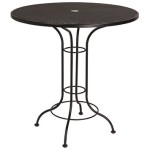How To Clean a Patio Rug: A Comprehensive Guide
Patio rugs enhance outdoor living spaces by adding comfort, style, and a touch of homeliness. However, being exposed to the elements, they are susceptible to dirt, debris, stains, and mold growth. Proper and regular cleaning is crucial to maintain their appearance, longevity, and hygiene. This article provides a comprehensive guide on how to effectively clean patio rugs, covering various cleaning methods and preventative measures.
The frequency of cleaning a patio rug depends on several factors, including its location, the amount of foot traffic it receives, and the prevailing weather conditions. Rugs in areas prone to dust storms, heavy rainfall, or excessive sun exposure will require more frequent cleaning compared to those in sheltered locations. As a general guideline, a light cleaning should be performed weekly, while a more thorough cleaning is recommended monthly, or more often as needed.
Key Point 1: Assessing the Rug and Gathering Supplies
Before commencing any cleaning process, a thorough assessment of the rug is vital. This involves identifying the rug's material composition, the type and severity of stains present, and any potential damage, such as fraying edges or tears. Different rug materials require different cleaning approaches; therefore, understanding the material composition is paramount.
Most patio rugs are made from synthetic materials, such as polypropylene, polyester, or nylon, due to their durability and resistance to moisture and fading. However, some rugs may contain natural fibers like jute or sisal. These natural fibers are more delicate and require specialized cleaning techniques.
Once the rug has been assessed, gather the necessary cleaning supplies. These supplies will vary depending on the chosen cleaning method but generally include:
*Broom or Vacuum Cleaner:
A broom or vacuum cleaner with a hose attachment is essential for removing loose dirt and debris. *Garden Hose:
A garden hose with a spray nozzle is necessary for rinsing the rug. *Mild Detergent or Soap:
A mild dish soap or a detergent specifically designed for outdoor rugs is recommended. Avoid using harsh chemicals or bleach, as they can damage the rug's fibers and fade its colors. *Bucket:
A bucket is needed for mixing the cleaning solution. *Scrub Brush:
A scrub brush with stiff bristles is useful for agitating the cleaning solution and removing stubborn stains. *Sponge or Cloth:
A sponge or cloth is helpful for applying the cleaning solution and blotting stains. *Optional Supplies:
Depending on the situation, other supplies such as a wet/dry vacuum, a pressure washer (used with caution), or specialized stain removers may be required.Always test the cleaning solution on an inconspicuous area of the rug before applying it to the entire surface. This will help to ensure that the solution does not cause any discoloration or damage.
Key Point 2: Various Cleaning Methods for Patio Rugs
Several cleaning methods can be employed to effectively clean a patio rug. The best method will depend on the rug's material, the severity of the stains, and the available resources. Here are some popular and effective cleaning techniques:
1. Sweeping or Vacuuming:
Regular sweeping or vacuuming is the most basic and essential step in maintaining a clean patio rug. This removes loose dirt, debris, leaves, and other particles that can accumulate on the rug's surface. This prevents these particles from becoming embedded in the fibers, making them more difficult to remove later. Sweep or vacuum the rug at least once a week, or more often if needed, depending on the amount of foot traffic and exposure to the elements.2. Hosing Down:
For rugs made from synthetic materials, simply hosing them down with water can be an effective way to remove light dirt and grime. This method is particularly useful after a light rain or when pollen is prevalent. Use a garden hose with a spray nozzle to thoroughly rinse the rug, ensuring that all dirt and debris are flushed away. Allow the rug to air dry completely before placing it back in its intended location.3. Soap and Water Cleaning:
For more stubborn dirt and stains, a solution of mild soap and water can be used. Mix a small amount of mild dish soap or outdoor rug detergent with water in a bucket. Apply the solution to the rug using a sponge or cloth, and then scrub the affected areas with a scrub brush. Rinse the rug thoroughly with a garden hose to remove all traces of soap. Ensure adequate rinsing to avoid soap residue, which can attract more dirt. Allow the rug to air dry completely before placing it back on the patio.4. Pressure Washing (with caution):
A pressure washer can be used to clean durable synthetic rugs, but extreme caution is advised. The high pressure can damage delicate fibers and break down the rug's backing. Use the lowest possible pressure setting and a wide nozzle to avoid concentrating the water stream in one area. Always test the pressure washer on an inconspicuous area of the rug before cleaning the entire surface. Hold the nozzle at a safe distance from the rug (at least 12 inches) and move it in a consistent, sweeping motion. Rinse the rug thoroughly to remove any remaining dirt and debris. Allow the rug to air dry completely.5. Specialized Stain Removal:
For specific types of stains, such as oil, grease, or wine, specialized stain removers may be necessary. Always follow the manufacturer's instructions when using stain removers, and test the product on an inconspicuous area of the rug first. Apply the stain remover to the affected area and allow it to sit for the recommended time. Then, blot the stain with a clean cloth or sponge, working from the outside in to prevent spreading. Rinse the area thoroughly with water and allow it to air dry. Repeat the process if necessary.6. Professional Cleaning:
For heavily soiled rugs or delicate rugs made from natural fibers, professional cleaning is often the best option. Professional rug cleaners have the expertise and equipment to safely and effectively clean a wide variety of rug materials. They can also provide specialized treatments for stains and odors. While professional cleaning is the most expensive option, it can extend the life of the rug and keep it looking its best.Key Point 3: Drying and Maintaining Your Patio Rug
Proper drying is essential to prevent mold and mildew growth, which can damage the rug and create unpleasant odors. After cleaning, always allow the rug to air dry completely before placing it back on the patio. The drying process can be expedited by implementing the following techniques:
1. Hanging the Rug:
If possible, hang the rug on a clothesline or over a railing to allow air to circulate on both sides. This will help the rug dry more quickly and evenly.2. Placing the Rug in Sunlight:
Sunlight can help to kill bacteria and speed up the drying process. However, prolonged exposure to direct sunlight can fade the rug's colors, so it's best to limit the amount of time it spends in direct sunlight.3. Using a Fan:
A fan can be used to circulate air around the rug and promote faster drying. Place the fan near the rug and direct the airflow towards it.4. Using a Wet/Dry Vacuum:
A wet/dry vacuum can be used to extract excess water from the rug after cleaning. This will significantly reduce the drying time.Once the rug is completely dry, consider applying a fabric protector spray to help repel water and stains. This will make it easier to clean the rug in the future and extend its lifespan. Fabric protector sprays are available at most home improvement stores.
Beyond the initial cleaning, preventative measures can significantly reduce the need for frequent deep cleaning. The following tips will help maintain a cleaner patio rug:
*Regular Sweeping/Vacuuming:
Consistent removal of loose debris prevents buildup and embedding into fibers. *Prompt Stain Removal:
Addressing spills and stains immediately prevents them from setting and becoming more difficult to remove. *Using Doormats:
Placing doormats at entry points helps to trap dirt and debris before they reach the patio rug. *Rotating the Rug:
Rotating the rug periodically helps to distribute wear and tear evenly, preventing certain areas from becoming overly soiled. *Storing the Rug During Off-Season:
During periods of inclement weather or when the patio is not in use, consider storing the rug in a dry, protected area to prevent damage and soiling.By following these guidelines, individuals can effectively clean and maintain their patio rugs, ensuring they remain an attractive and functional part of their outdoor living space for years to come. Regular cleaning and preventative measures are key to preserving the rug's appearance, extending its lifespan, and maintaining a hygienic outdoor environment.

Tips For Outdoor Patio Care How To Clean Rugs In Honor Of Design

Clean A Moldy Rug Spring Cleaning Tips

How To Clean An Indoor Outdoor Area Rug The Frugal Ginger

How To Clean An Outdoor Rug Without Bleach

Clean A Moldy Rug Spring Cleaning Tips

How To Clean An Outdoor Rug On Polka Dot Chair Blog

How To Clean An Outdoor Rug Without Bleach

How To Clean Outdoor Rugs

Easily Clean Your Outdoor Rug Flower Patch Farmhouse

Easily Clean Your Outdoor Rug Flower Patch Farmhouse








